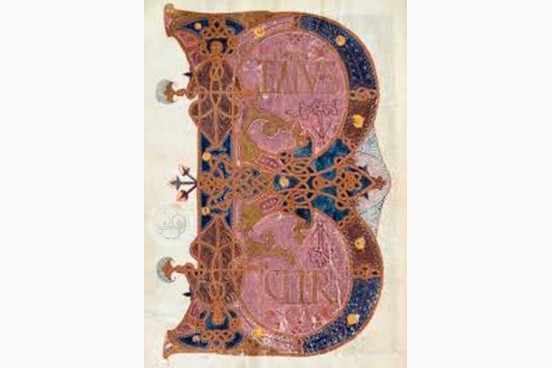The Prayer Book of Ferdinand and Sancha is a deluxe manuscript of Christian biblical and liturgical texts created in 1055 at the request of Queen Sancha for her husband, Ferdinand I, King of Castile and León. The manuscript's colophon credits Petrus as its scribe and Fructuosus as its illuminator. It is a handsome book and boasts a full-page presentation miniature, a full-page acrostic naming Ferdinand and Sancha, and five decorated incipit and text pages, including three pages of text written in gold display script on colored grounds.
The core texts of the prayer book are the biblical psalms (fols. 7r-136v), 106 biblical canticles (fols. 137r-196r), and a section of prayers, psalms, other texts, and chants with music notation for Matins, the long prayer service of the Divine Office celebrated before daybreak (fols. 209r-224v).
Presented to a King
The manuscript's lavish illumination is all the work of Fructuosus, who was aware of new artistic developments north of the Pyrenees. The hem of Christ's golden tunic in the large letter A of the frontispiece has the windswept appearance found in contemporary Ottonian art (fol. 1r). The presentation miniature is a singular image, the upper half dominated by a wall hanging and the lower half showing Ferdinand receiving the book from Sancha through an intermediary, whose identity—whether scribe, artist, or court official—is difficult to determine (fol. 3v/6v).
Zoomorphic and Anthropomorphic Initials
Fructuosus created inventive painted letters, many sparkling with gold, to introduce each psalm and canticle. Some letters are entirely composed of a human or animal figure. For example, a crowned King David forms the initial I of Psalm 30, and a reclining, haloed man wearing a long tunic forms the letter Q of Psalm 72 (fols. 29v and 66v). A leaping animal with golden antlers forms the opening S of Psalm 41 and a curving bird the U of Psalm 94 (fols. 41r and 88v).
Characteristic Script of Iberia
The scribe, Petrus, wrote the main text in long lines (a single column) in Visigothic Minuscule, an idiosyncratic Spanish script of tall, thin proportions (matched by the tall, thin proportions of the pages). Each verse of the psalms and canticles begins on a new line with its first letter in gold in the left margin.
Rare Example of Early Spanish Music Notation
The melodies of the chants in the last portion of the book are written in neumes in campo aperto ("in an open field"), indicating the contours but not the exact pitches of the melodies. This notation could only have served as a memory aid for someone who already knew the melodies, which we would not expect from the royal couple.
A Treasure of the University Library
It is uncertain where the manuscript was made, whether at the Benedictine monastery at Sahagún, which enjoyed royal favor, or elsewhere in the Kingdom of León. The manuscript entered the university library at Santiago in 1835, following the confiscation of property from the city's Benedictine monastery of San Martín Pinario. Some of its leaves have been scrambled in the course of the book's binding history. The current binding of blind tooled leather dates from 1973.
We have 1 facsimile edition of the manuscript "Prayer Book of Ferdinand and Sancha": Libro de Horas de Fernando I de León facsimile edition, published by Testimonio Compañía Editorial, 1995
Request Info / Price
